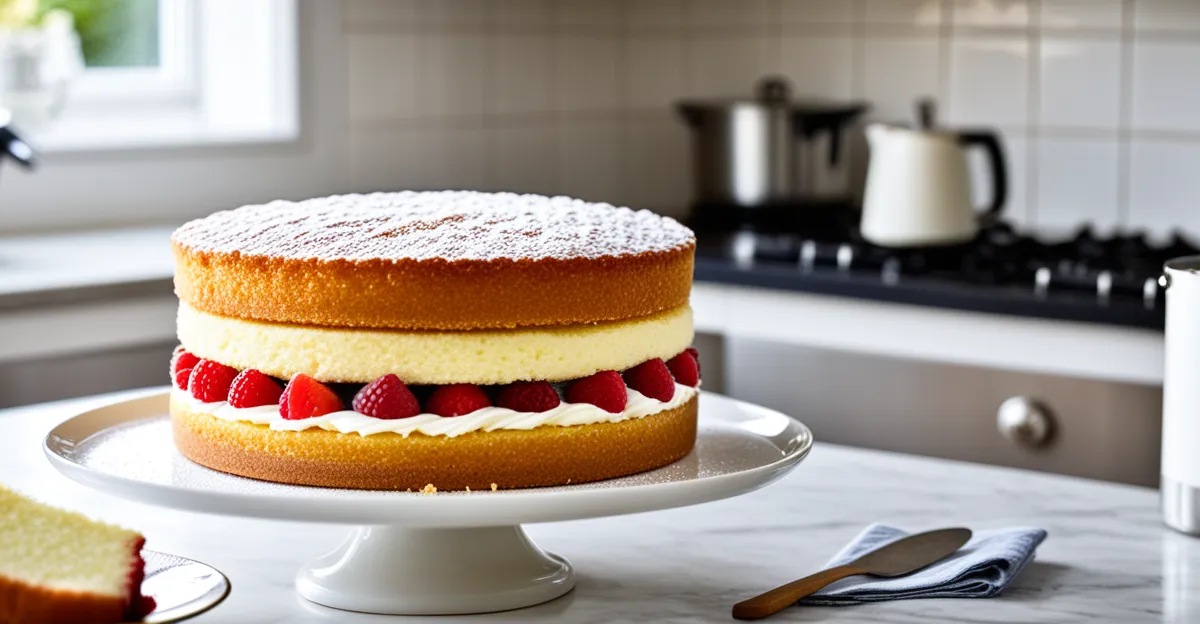Essential Ingredients and Equipment for a Fluffy Victoria Sponge Cake
Creating a perfectly fluffy Victoria sponge cake starts with selecting the right victoria sponge ingredients and having the appropriate baking equipment. The classic recipe demands:
- 200g unsalted butter, softened
- 200g caster sugar
- 4 large eggs
- 200g self-raising flour, sifted
- A pinch of baking powder
Using fresh, high-quality ingredients is crucial. Fresh eggs and properly sifted flour help trap air, increasing fluffiness. The freshness of butter and sugar also impacts the cake’s texture and taste.
Also to discover : What are the key steps to making a classic Victoria sponge cake?
Regarding cake essentials, reliable equipment includes an electric mixer for effective creaming, a kitchen scale for accurate measurements, and two identical 20cm round cake tins lined with baking paper. Consistent tin size ensures even baking and a level rise. A thermometer to verify oven temperature can prevent common baking errors resulting in dense cakes. Proper preparation of the baking apparatus supports maintaining the structural integrity necessary for a light sponge.
Step-by-Step Guide to Mixing and Preparing the Batter
Mastering the victoria sponge method begins with the crucial step of creaming butter and sugar until light and pale. This process incorporates air, forming the base for a fluffy sponge. Using an electric mixer set at medium speed ensures even aeration without overheating the fat.
Also to see : What are the secrets to creating a perfect Cornish pasty?
Next, eggs should be added gradually, one at a time, mixing thoroughly after each addition. This allows the sugar to dissolve properly and prevents the mixture from curdling. Properly incorporating eggs is essential to maintaining a smooth, stable batter.
Sifting the flour is a non-negotiable technique in cake batter preparation. It removes lumps, aerates the flour, and enables even distribution when folding into the butter mixture. Folding—not stirring or beating—is critical here; gently incorporating the flour with a spatula preserves the entrapped air bubbles.
Repeatedly folding in the victoria sponge ingredients ensures a consistent, light batter. Overmixing risks deflating the sponge, resulting in a dense cake. Pay close attention to the batter’s texture: it should feel silky and airy, signaling readiness for baking. This meticulous approach to mixing techniques is foundational for achieving a tender, fluffy victoria sponge.
Baking the Victoria Sponge: Timing and Temperature
Achieving the ideal baking temperature is critical for a fluffy victoria sponge. Set your oven to precisely 180°C (350°F) for consistent heat distribution. This temperature promotes even rising and golden crust formation without drying out the sponge.
Position your cake tins on the middle shelf to ensure balanced airflow and prevent uneven baking. Placing tins too close to the top or bottom can cause burning or undercooked centers. Maintain this shelf setting throughout the entire victoria sponge timing process to optimize texture and rise.
Bake for 20 to 25 minutes, but always rely on visual and tactile cues. A perfectly baked sponge will have a light golden colour, spring back when pressed gently, and shrink slightly from the tin edges. Insert a skewer; it should come out clean to confirm doneness.
Precise control of oven settings and timing avoids common pitfalls like soggy or dense sponges. Consistency here guarantees the delicate crumb characteristic of a well-made victoria sponge cake. Monitoring closely – rather than just trusting the timer alone – results in the fluffiest cake texture possible.
Baking the Victoria Sponge: Timing and Temperature
Achieving the perfect fluffy victoria sponge depends heavily on precise baking temperature and timing. The ideal oven setting is typically around 180°C (350°F) for conventional ovens. This temperature promotes even rising without browning the cake too quickly, which can dry out the crumb. Positioning the cake tins on the middle shelf ensures balanced heat circulation, vital for a uniform bake and optimal fluffiness.
How long should the cake bake? Usually, a baking time between 20 to 25 minutes is recommended. Exact timing varies with oven performance and tin material. To confirm doneness, insert a skewer into the centre; if it comes out clean, the sponge is baked perfectly. Avoid opening the oven door frequently during baking, as temperature fluctuations can cause the sponge to collapse.
Precise oven settings paired with consistent timing minimize common pitfalls. Overbaking leads to a dry, crumbly texture, while underbaking results in a soggy center. Investing in a reliable oven thermometer helps maintain an accurate baking temperature, crucial for fluffy cake outcomes. Careful attention to these factors ensures your victoria sponge timing and oven settings contribute effectively to a light, tender cake.
Essential Ingredients and Equipment for a Fluffy Victoria Sponge Cake
Achieving a truly fluffy victoria sponge cake depends on precise use of victoria sponge ingredients combined with proper baking equipment. The standard sponge calls for equal weights of 200g each of unsalted butter (softened), caster sugar, and self-raising flour, plus 4 large eggs and a pinch of baking powder. The balance of these ingredients works synergistically to create the desired crumb and lift.
Quality and freshness of ingredients directly influence the cake’s texture. Fresh eggs contribute structure as their proteins coagulate during baking, aiding fluffiness. Using high-grade butter adds richness and moisture, while fresh caster sugar ensures effective creaming with butter, trapping essential air pockets. Sift the flour to aerate it, gently distributing it during folding to avoid deflating the batter.
For cake essentials, reliable baking equipment is a foundation. An electric mixer accelerates effective creaming of butter and sugar, crucial for aeration. Accurate kitchen scales guarantee precise measurements—vital since imbalance may cause a dense sponge. Two identical 20cm round tins lined with baking paper ensure even heat transfer and consistent rising. Lastly, a good oven thermometer aids maintaining ideal temperature, preventing common baking mistakes that could compromise fluffiness.
Essential Ingredients and Equipment for a Fluffy Victoria Sponge Cake
Achieving a fluffy Victoria sponge cake hinges on precise victoria sponge ingredients paired with the right baking equipment. The ideal recipe uses 200g each of softened unsalted butter, caster sugar, and self-raising flour, plus 4 large eggs and a pinch of baking powder. This exact balance ensures the sponge rises evenly and maintains a tender crumb.
Freshness is critical. Fresh eggs provide structural proteins that set during baking, enhancing fluffiness. High-quality butter contributes moisture and a rich texture, while fresh caster sugar aids in the creaming process, trapping air effectively. Sifting the flour is essential to aerate it and eliminate lumps, preparing it for gentle folding.
Regarding cake essentials, the choice of equipment impacts the outcome significantly. An electric mixer efficiently creams butter and sugar, incorporating air crucial for lightness. Kitchen scales ensure ingredient accuracy, preventing imbalance that causes density. Two identical 20cm round tins lined with baking paper promote uniform baking, while an oven thermometer guarantees maintaining the right temperature. Such baking equipment fosters consistency and precision, both vital for a fluffy Victoria sponge cake.
Essential Ingredients and Equipment for a Fluffy Victoria Sponge Cake
Selecting the right victoria sponge ingredients is fundamental to producing a light, airy cake. The standard measurements include 200g unsalted butter (softened), 200g caster sugar, 4 large eggs, 200g self-raising flour (sifted), and a pinch of baking powder. These precise proportions enable balance between moisture, structure, and lift, which are critical for fluffiness.
Ingredient freshness directly impacts the sponge’s texture. Fresh eggs provide essential proteins that coagulate during baking, forming a strong yet tender crumb. Using high-quality butter and caster sugar is equally important; fresh butter retains moisture, while caster sugar dissolves evenly, promoting optimal creaming.
In terms of baking equipment, accurate tools underlie consistent results. An electric mixer efficiently creams butter and sugar, incorporating air—an indispensable part of the cake essentials. Precise kitchen scales ensure correct ingredient ratios, avoiding issues from imbalance. Two identical 20cm round tins lined with baking paper guarantee even heat distribution, so the cake rises uniformly. Finally, an oven thermometer enables stable baking temperature control, crucial for avoiding common problems like uneven baking or dense patches. Employing proper baking equipment combined with fresh ingredients sets the foundation for a beautifully fluffy victoria sponge cake.







